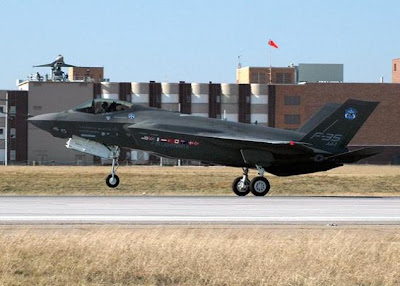19 April 2013
JSF F-35 (photo : armybase)
JSF model to study electromagnetic effects
The Minister for Defence Science and Personnel, Warren Snowdon, today unveiled a full-scale model of the F-35A Joint Strike Fighter (JSF) which DSTO will use to study the effects of electromagnetic compatibility and interference on the aircraft.
Called Iron Bird, the Australian-built model will be tested under simulated electromagnetic conditions during the acquisition and through-life sustainment of the JSF.
The study is a significant part of ensuring the protection of the JSF against electromagnetic environmental effects such as lightning and static discharge which can impair the performance and safety of aircraft.
The JSF is a fifth-generation aircraft with highly complex electronics, sophisticated software and a structural airframe made of composite materials. This exposes the aircraft to electromagnetic interference from both naturally occurring phenomena and man-made sources, including telecommunication transmissions and radar. The impact of these interferences needs to be well understood and appropriately managed.
DSTO has developed world-class expertise in the investigation of electromagnetic radiation impact on aircraft and is engaged directly with the United States JSF Joint Project Office to undertake this study using the Iron Bird model.
The data captured will help in providing potential reductions in the cost of owning the JSF fleet and enhancing the aircraft’s capability.
The DSTO test methods provide a rapid, cost-effective means of assessing and monitoring the JSF’s ability to withstand electromagnetic exposure and minimise any impact on its systems and performance. The research will support the verification for compliance and airworthiness certification for the JSF aircraft.
Australia’s first two F-35As are due to be delivered to a United States-based training facility during 2014‑15 when Royal Australian Air Force (RAAF) pilot and maintainer training will commence on the aircraft.
The Defence Science and Technology Organisation (DSTO) is part of Australia's Department of Defence. DSTO's role is to ensure the expert, impartial and innovative application of science and technology to the defence of Australia and its national interests.
(DSTO)
JSF F-35 (photo : armybase)
JSF model to study electromagnetic effects
The Minister for Defence Science and Personnel, Warren Snowdon, today unveiled a full-scale model of the F-35A Joint Strike Fighter (JSF) which DSTO will use to study the effects of electromagnetic compatibility and interference on the aircraft.
Called Iron Bird, the Australian-built model will be tested under simulated electromagnetic conditions during the acquisition and through-life sustainment of the JSF.
The study is a significant part of ensuring the protection of the JSF against electromagnetic environmental effects such as lightning and static discharge which can impair the performance and safety of aircraft.
The JSF is a fifth-generation aircraft with highly complex electronics, sophisticated software and a structural airframe made of composite materials. This exposes the aircraft to electromagnetic interference from both naturally occurring phenomena and man-made sources, including telecommunication transmissions and radar. The impact of these interferences needs to be well understood and appropriately managed.
DSTO has developed world-class expertise in the investigation of electromagnetic radiation impact on aircraft and is engaged directly with the United States JSF Joint Project Office to undertake this study using the Iron Bird model.
The data captured will help in providing potential reductions in the cost of owning the JSF fleet and enhancing the aircraft’s capability.
The DSTO test methods provide a rapid, cost-effective means of assessing and monitoring the JSF’s ability to withstand electromagnetic exposure and minimise any impact on its systems and performance. The research will support the verification for compliance and airworthiness certification for the JSF aircraft.
Australia’s first two F-35As are due to be delivered to a United States-based training facility during 2014‑15 when Royal Australian Air Force (RAAF) pilot and maintainer training will commence on the aircraft.
The Defence Science and Technology Organisation (DSTO) is part of Australia's Department of Defence. DSTO's role is to ensure the expert, impartial and innovative application of science and technology to the defence of Australia and its national interests.
(DSTO)

















